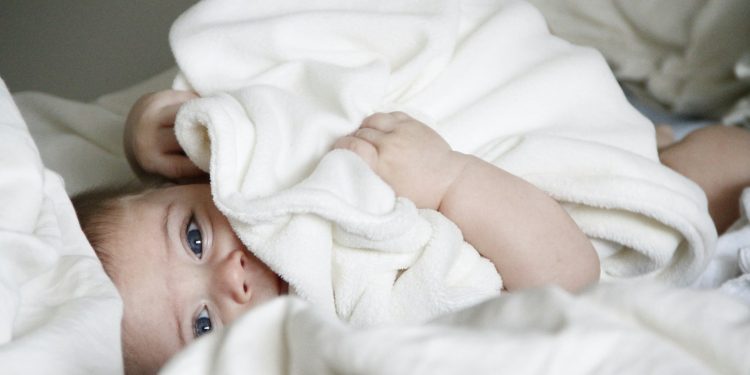When it comes to caring for a newborn, parents often focus on several essentials: feeding, sleeping, and ensuring a safe environment. However, one of the most overlooked aspects is the type of fabric that comes into contact with a baby’s delicate skin. Babies have sensitive skin that is thinner and more susceptible to irritation than adult skin. This sensitivity requires thoughtful consideration when selecting clothing, blankets, and other fabric items for your little one. The right fabric can prevent rashes, allergies, and discomfort, ensuring that your baby is as happy and comfortable as possible.
Understanding Baby’s Sensitive Skin
Before diving into fabric choices, it’s essential to understand why babies have such sensitive skin. A newborn’s skin is approximately 30% thinner than an adult’s, making it more prone to irritation and allergic reactions. Additionally, babies produce fewer natural oils, which means their skin can easily become dry and irritated. Factors like temperature, humidity, and the presence of allergens can exacerbate these conditions.
Because of these vulnerabilities, the choice of fabric is crucial. Parents should be on the lookout for materials that not only feel good against the skin but also offer protection from irritants and allergens.
Factors to Consider When Choosing Fabrics
When selecting fabrics for your baby’s clothing and bedding, there are several key factors to keep in mind:
- Breathability: Fabrics that allow air to circulate are essential for keeping your baby comfortable. Breathable fabrics help regulate temperature, preventing overheating, which can lead to discomfort or even heat rash. Natural fibers like cotton and linen are excellent choices as they allow moisture to escape and keep the skin dry.
- Softness: The softness of a fabric directly impacts a baby’s comfort level. Rough or scratchy materials can irritate sensitive skin, leading to fussiness and discomfort. Always choose fabrics that are soft to the touch. Organic cotton, bamboo, and modal are great options known for their gentle textures.
- Hypoallergenic Properties: Babies can be sensitive to certain substances in fabrics, such as dyes, chemicals, and synthetic fibers. Selecting hypoallergenic materials can help minimize the risk of allergic reactions. Organic fabrics, which are free from harmful chemicals and dyes, are an excellent choice for babies with skin sensitivities.
- Durability: Babies can be messy, and their clothes often need frequent washing. Choosing durable fabrics ensures that clothing can withstand regular washing without losing its shape or softness. Cotton blends tend to be more durable while still being gentle on the skin.
- Ease of Care: Babies often have accidents, so choosing fabrics that are easy to wash and care for is important. Look for machine-washable materials that can endure frequent laundering without compromising quality.
Best Fabrics for Baby’s Sensitive Skin
With these factors in mind, here are some of the best fabric choices for baby clothes and other items:
1. Organic Cotton
Organic cotton is one of the best fabrics for babies due to its softness, breathability, and hypoallergenic properties. Unlike conventional cotton, organic cotton is grown without harmful pesticides and chemicals, making it a safe choice for sensitive skin. It allows air circulation, keeping babies cool and comfortable. Furthermore, organic cotton clothing is often produced with minimal environmental impact, appealing to eco-conscious parents.
2. Bamboo
Bamboo fabric is another excellent choice for babies. It’s incredibly soft, often compared to silk, and has natural antibacterial and moisture-wicking properties. Bamboo fibers are breathable, which helps regulate body temperature, making it ideal for both warm and cool climates. Additionally, bamboo fabric is hypoallergenic, reducing the likelihood of skin irritations.
3. Modal
Modal is a type of rayon made from beech tree pulp. It’s known for its incredible softness and silky feel, making it a comfortable option for babies. Modal is also breathable and has excellent moisture-wicking abilities, keeping your baby dry and comfortable. Like bamboo, modal is biodegradable, making it an environmentally friendly choice.
4. Hemp
Hemp fabric is durable, breathable, and naturally resistant to mold and mildew. While it may not be as soft as cotton or bamboo initially, hemp becomes softer with each wash. Hemp is also a sustainable fabric choice, as it requires fewer resources to grow than cotton. Its hypoallergenic properties make it suitable for babies with sensitive skin.
5. Linen
Linen is made from flax fibers and is known for its breathability and moisture-wicking properties. While it has a slightly rough texture compared to cotton, linen softens over time with washing. It’s a great option for warm weather due to its ability to keep the body cool. However, some parents may prefer to use linen for blankets and bedding rather than clothing, as its texture may not be as gentle against the skin as other fabrics.
Fabrics to Avoid
While there are plenty of suitable fabrics, some should be avoided when dressing your baby. These include:
- Synthetic Fabrics: Materials like polyester, nylon, and acrylic are not breathable and can trap heat and moisture against the skin. They are also more likely to cause irritation and allergic reactions.
- Wool: While wool is warm and durable, it can be itchy and irritating to sensitive skin. If you want to use wool, look for softer varieties like merino wool, which can be gentler but may still pose a risk of irritation for some babies.
- Dyes and Chemicals: Fabrics treated with harsh dyes or chemicals can irritate a baby’s skin. Always opt for clothing labeled as free from harmful chemicals and dyes, particularly for items that will have prolonged contact with the skin.
Tips for Parents
Choosing the right fabric for your baby is just one part of the equation. Here are some additional tips to keep in mind:
- Test the Fabric: Before purchasing new clothes, feel the fabric against your skin. If it feels rough or irritating to you, it may be the same for your baby.
- Wash Before Use: Always wash new clothing before your baby wears it. This removes any residual chemicals and softens the fabric, making it more comfortable.
- Layer Wisely: When dressing your baby, consider layering with breathable fabrics to regulate temperature. This allows you to add or remove layers as needed without overheating.
- Observe Reactions: Keep an eye on your baby’s skin after introducing new fabrics. If you notice any irritation, discontinue use and opt for softer, hypoallergenic alternatives.













